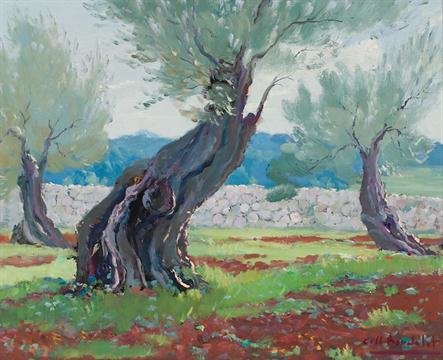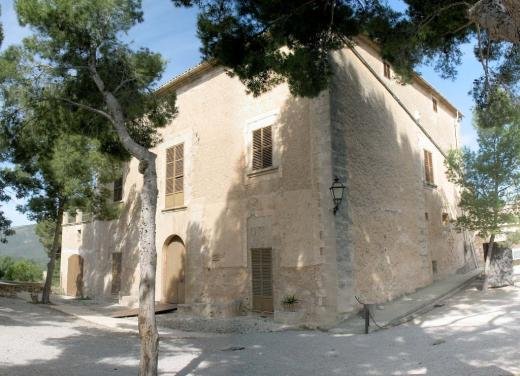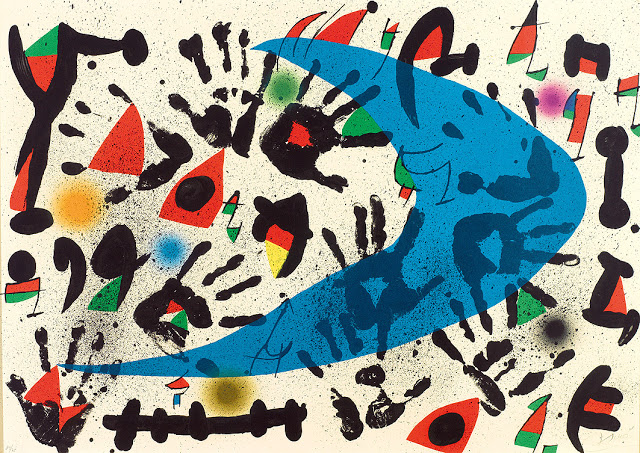During the last seven days I have been soaking up the sun and heat of Mallorca and now, whilst sheltering from the continual rain, I thought I would look at two artists who had an attachment to this Balearic Island. Their work could not have been more different. The artwork of the first artist was bright and beautiful whilst the work of the second artist, who is, by far, more famous, left me unmoved but I will try not to judge and simply accept that beauty is in the eye of the beholder.

The first artist I am featuring is the Catalan painter Josep Coll Bardolet, whose work I came across at a gallery in the quaint Mallorcan town of Valldemossa. He was born in November 1912 on mainland Spain, in Campdevànol, a village in the province of Girona. When he was fifteen years old the family moved to the city of Vic, a small town twenty miles south of where he was born and where Coll Bardolet began his education at the Escola Municipal de Dibuix and worked as a painter and decorator. It is in that year in Vic that he held his first exhibition of his paintings. Having developed a love of landscape painting he then enrolled at the Landscape Painting School in Olot, which is now known as Escola d’Art i Superior de Disseny d’Olot . The town of Olot, which lay twenty miles east of Campdevànol, is known for its natural landscape, including four volcanoes which are scattered around the city centre. The town was also famous for its cultural activity, with its various art movements such as the Olot School of landscape painting. The Olot School was a group of painters that created an artistic style in the second half of the 19th century, similar to the French Barbizon School.

In July 1936, the Spanish Civil War broke out and Bardolet, being a pacifist, decided to leave his homeland and cross the border to France. He travelled to Tours and here he studied at the town’s Academy of Fine Arts. The following year he moved to Brussels where he was appointed professor at the city’s Académie Royale des Beaux-Arts.

In 1939 he returned to Spain and his beloved Catalonia and it is whilst here that he makes a number of journeys to Mallorca, each time staying longer and longer on the island. He was fascinated by the island’s light, landscape and its folk dances and it is these themes which play a major part of his art. His paintings were exhibited both on the mainland at Barcelona and on the island at Palma. His love of the island grew over the years and finally in 1944 he settled permanently in Valdemossa. He bought a house with a studio and a garden next to the Charterhouse of Valldemossa, a former Carthusian monastery, which is now a museum. Here he lived with a small dog, a cook and a housekeeper. Over the next twenty years he worked tirelessly completing paintings which are exhibited in galleries throughout Europe as well as Boston, USA.

In 1987 he was declared an honorary citizen of Valldemossa, the town he had made his home for over forty years. In 1988, in recognition of his achievements the Coll Bardolet Art Gallery was opened in Campdevànol, the village where he was born seventy-six years before.

Thirty miles north-east of where Bardolet used to live in Valldemossa is the town of Escorca and there is the Santuari de Lluc, a monastery and pilgrimage site. In 1984, with the celebration of the centenary of the Coronation of the Virgin the museum expanded with the addition of a considerable acquisition of modern art and sculpture, which was further extended to include rooms dedicated to the work of Josep Coll Bardolet who made two donations totalling 236 works of art in 1989 and 1995. The new and definitive collection was opened on 10th September, 1995 and is made up of the Coll Bardolet Collection of portraits, drawings, gouache and water-colours.

In 1990 Bardolet was awarded the Saint George Cross by the Autonomous Government of Catalonia and the Gold medal of the Community of the Balearics Islands. The Coll Bardolet Cultural Foundation was established in 2005 with the works donated by him to the town of Valdemossa. The Foundation has two main objectives. The first is to preserve, exhibit and publicise the pictorial work of Josep Coll Bardolet and the Foundation’s private collection of his work, and the second is to promote the fine arts in all of their facets and forms. The Foundation, which I visited last week, is in a three storey building in the centre of Valldemossa. The first floor of the building features a permanent exhibition of Coll Bardolet’s paintings, which primarily consist of landscapes of Mallorca, though they also include still lifes, flower compositions and his well-known renderings of traditional Mallorcan folkdance scenes. The second floor houses temporary exhibitions, and the ground-level floor accommodates different cultural activities, such as conferences and concerts. The building was restored under the auspices of the Balearic Islands Government and the Valdemossa Town Council. The works in this permanent collection captivate the beautiful Mallorcan scenery.

(1912 – 2007)
Josep Coll Bardolet died in Valdemossa in July 2007, aged ninety-four.
———————————————————

The second artist I am featuring today is the Barcelona-born painter who also had a connection with Mallorca. He is Joan Miró. I visited the museum dedicated to his art work, the Fundación Pilar i Joan Miró (Pilar and Joan Miró Foundation) museum whilst visiting Cala Major just a little way west of Palma. Although born in Catalonia, both his mother and wife came from the Balearic Island of Mallorca. The museum is comprised of a main building which houses his works which he donated, a library, a sculpture garden, Miró’s Sert studio, a building designed by his friend of twenty-five years, the Spanish architect and city planner, Josep Sert.

In 1937, Josep Sert designed the Pavilion of the Spanish Republic for the Paris Exposition Universelle, for which Miró painted a large format oil painting, The Reaper, also known as El campesino catalán en rebeldía (Catalan peasant in revolt).

It was an enormous mural, 5.5metres tall. Sadly it was destroyed or lost in 1938 and only a few black and white photographs survive, including one showing Miró working on the mural.

The Sert studio is the one he used from the time he arrived on the island in 1956 until his death in 1983. Almost twenty years earlier, in May 1938, whilst living in exile in Paris, he wrote about how owning his own spacious atelier would give him so much pleasure:
“My dream, when I can set somewhere, is to have a large workshop, not so much for lighting, north light, etc., that I find indifferent as to have more space, many fabrics, because the more I have work, the more you come to me to do “.
In 1956 his Sert atelier was ready for him and Miró remembered the time well, saying:
“…In the new study, I had enough space for the first time. I could unpack boxes containing works long ago […] When I took everything in Mallorca, I started myself […] I was ruthless with myself. I destroyed many fabrics, especially a lot of drawings and gouaches… “

Also on the land, there is the Finca Son Boter which he often used as a studio. The structure is of a typical eighteenth century Mallorcan manor house and its name derives from the surname of the owner of the land in the fourteenth century, the merchant Llorenc Boter. The closeness of Son Boter to his Sert studio was commented upon in Miró’s letter to Josep Sert. In October 1959, he wrote:
“…I just bought Son Boter, the magnificent house located behind ours. What, besides being a good investment, puts us safe from possible fastidious neighbors. I also serve to make fabrics and monumental sculptures, as well as to decongest the workshop…”

The cost of the building was probably offset thanks to the funding which came with the Guggenheim prize, which he had won in 1958 for the creation of two ceramic murals he did for the UNESCO headquarters in Paris.

Joan Miró maintained a close relationship with Mallorca throughout his life. Although he was born in Barcelona on April 20, 1893, his mother, Dolores Ferrà, and his maternal grandparents were from Mallorca and from 1900, when he was only seven years, he began to spend part of the summer with his maternal grandmother in Mallorca.

In 1920 Miró made his first trip to Paris, which would was to prove the turning point in his life. In October 1929 his ties with Mallorca strengthened when he married Pilar Juncosa Iglesias. Pilar’s mother, Enriqueta, was cousin of Miró’s grandmother.
 In 1936 he travelled to Paris with his latest works, which were to be exhibited in New York. When the Spanish civil war broke out, he decided to stay in Paris and his wife and daughter joined him. He lived and worked in an apartment at 98 Boulevard Auguste Blanqui, Paris and attended life classes at the Académie de la Grande Chaumière, where he produced a large number of drawings. In the summer of 1939, with the onset of the Second World War he and his family left Paris and moved to Varengeville-sur-Mer in Normandy, where he rented a house and where the family remained until 1940.
In 1936 he travelled to Paris with his latest works, which were to be exhibited in New York. When the Spanish civil war broke out, he decided to stay in Paris and his wife and daughter joined him. He lived and worked in an apartment at 98 Boulevard Auguste Blanqui, Paris and attended life classes at the Académie de la Grande Chaumière, where he produced a large number of drawings. In the summer of 1939, with the onset of the Second World War he and his family left Paris and moved to Varengeville-sur-Mer in Normandy, where he rented a house and where the family remained until 1940.
 At the end of May 1940 the Germans bombed Normandy and Miró decided to return to seek refuge in Spain with his family. His fame had by now crossed the Atlantic and in 1947 during his first trip to America, he produced a mural painting for the Gourmet Room at the Terrace Plaza Hotel in Cincinnati.
At the end of May 1940 the Germans bombed Normandy and Miró decided to return to seek refuge in Spain with his family. His fame had by now crossed the Atlantic and in 1947 during his first trip to America, he produced a mural painting for the Gourmet Room at the Terrace Plaza Hotel in Cincinnati.
Initially, Miró and his family had left France for Barcelona, but Miró had been an active sympathiser for the Republican struggle during the Spanish Civil War a few years earlier and this made him unpopular with Franco’s new regime, and so in 1956, he and his family decided to set up home in the relative isolation of Mallorca. .
 In 1956 Miró summed up his love of the Balearic Island:
In 1956 Miró summed up his love of the Balearic Island:
“…This wonderful country … We are about to buy a house near Palma in a beautiful land. Dividing my time between here [Mallorca] and Paris, and occasionally travelled to New York, would be ideal for work and health… “
Joan Miró died in Palma de Mallorca on Christmas Day 1983, aged 90. He was buried in the Montjuïc cemetery, Barcelona on December 29th.

I have purposely not commented on the paintings as they are not the kind of art that I can understand or appreciate. I am however mindful of what somebody once told me. They said I must embrace all types of art and never make the crass comment that a child could have done better ! As I said at the beginning, beauty is in the eye of the beholder, so maybe this is your type of art, and if it is, enjoy.

More Miro !!! He is wonderful.
Although I appreciate Miro I too prefer Coll Bardolet paintings. He is new to me so thank you once again for the introduction.
I didn’t know Bardolet untill my holiday in Mallorca recently.It was great to see his wonderfull paintings.